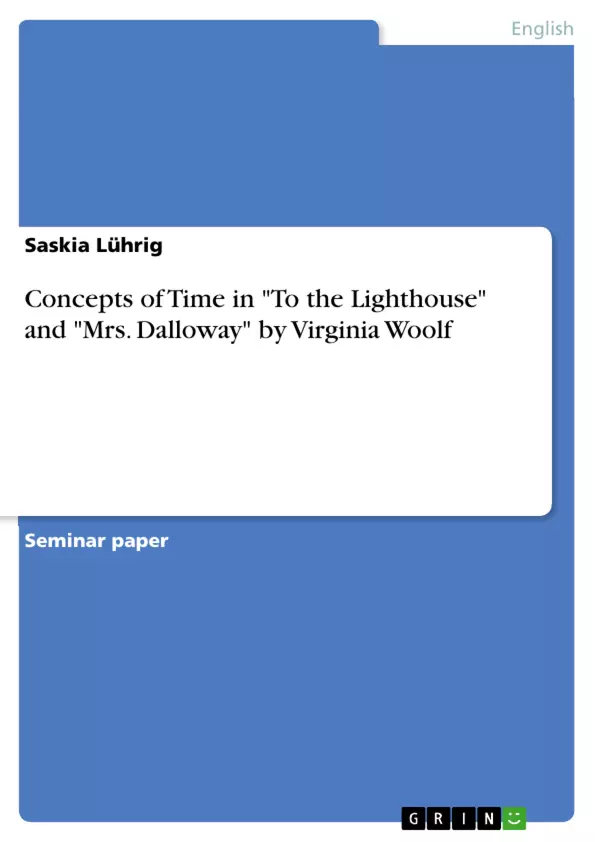Virginia Woolf is regarded as one of the great writers in modern fiction. She wrote innovative pieces of fiction for she used the stream-of-consciousness and experimented with different point of views. Furthermore, the treatment of time is an important issue in her fiction as she broke with the traditional chronological narration. This paper will discuss Virginia Woolf’s concepts of time theoretically and in her novels Mrs Dalloway and To the Lighthouse.
First of all, it is necessary to understand that time itself is and has always been a problematic concept which has been subject to philosophical discussion. People have been obsessed with control and domination of time. They measure it and create linear segments, such as days, minutes and seconds. In Modernism, new concepts of time came up and especially the concepts of time by Henri Bergson influenced the writers of Modernism. Woolf as a modern writer and critic was strongly influenced by these new concepts. This can be seen in her experimental fiction and her usage of time in her novels. Therefore, a brief outline of the main characteristics of Modernism will be given to understand the context in which the discussion is embedded. Furthermore, Henri Bergson’s concepts of time will be presented briefly as they have been the most influential in modern fiction. Finally, Woolf’s own theoretical concepts of time will be explained. She concentrated especially on the distinction between moments of being and non-being which will be defined.
In the following, it will be examined how she applied these concepts of time in two of her novels. Mrs Dalloway, published in 1925, and To the Lighthouse, written and published after Mrs Dalloway in 1927, will be analysed with a special focus on the treatment of time. It will be examined how time influences the structures of the novels and how its dimensions, past and present, are treated. Especially past times effecting present situation and present moments evoking past memories are of importance. Furthermore, this paper will identify moments of being in the novels and analyse how they are perceived in respect to time. Finally, the treatment of time in the two novels will be compared. It will be examined if there is a development in her concepts and if so, the changes will be highlighted.
Table of Contents
- Introduction
- Theoretical Background
- Time in Mrs Dalloway and To the Lighthouse
- Time in Mrs Dalloway
- Time's Influence on the Novel's Structure
- Past and Present
- Moments of Being
- Time in To the Lighthouse
- Time's Influence on the Novel's Structure
- Past and Present
- Moments of Being
- Time in Mrs Dalloway
Objectives and Key Themes
This paper aims to analyze Virginia Woolf's concepts of time, both theoretically and as they are presented in her novels, Mrs. Dalloway and To the Lighthouse. It explores how Woolf departs from traditional chronological narration and incorporates innovative techniques to represent the subjective experience of time.
- Woolf's theoretical understanding of time, influenced by modernism and philosophical thought.
- The relationship between past and present in Woolf's novels.
- The concept of "moments of being" and their significance in Woolf's work.
- The impact of time on the structure and narrative of Mrs. Dalloway and To the Lighthouse.
- A comparative analysis of the treatment of time in both novels.
Chapter Summaries
Introduction: This chapter introduces Virginia Woolf as a modernist writer who innovatively uses stream-of-consciousness and explores the complexities of time in her fiction. It establishes the paper's focus on examining Woolf's concepts of time theoretically and through an analysis of Mrs. Dalloway and To the Lighthouse.
Theoretical Background: This section provides context by discussing Woolf's views on modern fiction, contrasting it with traditional approaches. It then outlines the influential concepts of time proposed by Henri Bergson, highlighting the dual nature of reality (space and time) and the importance of individual intuition in perceiving time. It also touches upon the impact of Freudian psychoanalysis on the understanding of the self and its relationship with time.
Time in Mrs. Dalloway and To the Lighthouse: This chapter delves into the specific treatment of time in each novel, exploring how time influences the narrative structure. It examines the interplay of past and present, focusing on how past experiences shape present situations, and how present moments evoke past memories. The analysis also identifies and examines "moments of being" within the novels.
Keywords
Virginia Woolf, Modernism, Stream-of-consciousness, Time, Narrative Structure, Mrs. Dalloway, To the Lighthouse, Past and Present, Moments of Being, Henri Bergson, Subjective Experience.
- Arbeit zitieren
- Saskia Lührig (Autor:in), 2006, Concepts of Time in "To the Lighthouse" and "Mrs. Dalloway" by Virginia Woolf, München, GRIN Verlag, https://www.grin.com/document/123439



